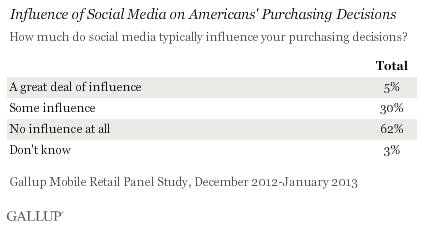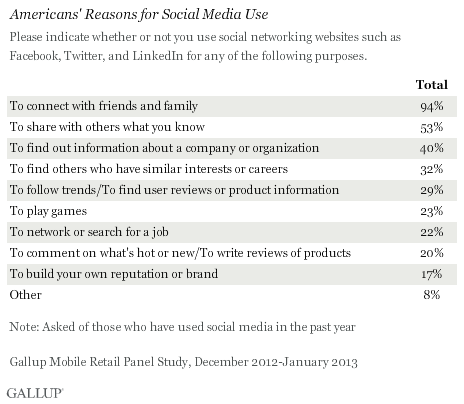WASHINGTON, D.C. -- A clear majority of Americans say social media have no effect at all on their purchasing decisions. Although many companies run aggressive marketing campaigns on social media, 62% in the U.S. say Facebook and Twitter, among other sites, do not have any influence on their decisions to purchase products.

Despite tremendous numbers of Americans using social media institutions such as Facebook, Google+, LinkedIn, and Twitter, only 5% say social media have "a great deal of influence" on their purchasing decisions, while another 30% say these channels have "some influence." These data, from Gallup's new State of the American Consumer report, are based on Americans' self-reported estimates of how much social media campaigns affect their purchasing decisions. While social media may have more influence than some Americans realize or will admit, these data show that relatively few consumers consciously take into account what they learn from social media when making purchases.
Millennials, a Key Social Media Audience, Not Influenced Much Either
Even millennials -- a generation that many companies regard as a key social media audience -- tend to say that social media marketing is not much of a factor in their decision-making. Among the four major generation groups that Gallup surveyed, millennials (those born after 1980) were the most likely to say that social media have at least some influence on their buying decisions (50%). But millennials were nearly as likely to say social media have no influence at all.

Social media's influence on Americans' purchasing decisions decreases with age. Among traditionalists (those born prior to 1946), a solid 75% say that social media do not have any impact on whether they purchase a product or service. The generational differences may reflect varying degrees of social media use across age groups.
Overwhelmingly, Americans Use Social Media to Connect With Friends, Family
Not surprisingly, an overwhelming 94% of social media users say they use these channels to connect with friends and family, illustrating the primary need that social media fulfill. Far less, 29%, say they use social media to follow trends and find product reviews and information, while 20% say they visit social networking sites to comment on what's new or write product reviews.

Even among American consumers who "like" or follow a company on Facebook or Twitter, 34% say that social media have no influence at all on their buying decisions, while 53% say they have some influence. Gallup research shows that when it comes to making purchasing decisions, consumers are much more likely to turn to friends, in-store displays, television commercials, and even mail catalogs and magazines than to consult a company-sponsored Facebook page or Twitter feed.
Bottom Line
U.S. companies spent a combined $5.1 billion on social media advertising in 2013, and they obviously believe that this presents them with a return on investment. However, a solid majority of American adults say that social media have no influence at all on their purchasing decisions -- suggesting that the advertising may be reaching smaller segments of the market, or that the influence on consumers is indirect or goes unnoticed.
In the State of the American Consumer report, Gallup reveals that consumers who engage with brands often do so when they are already attached to a product or service. Companies that engage their customers -- by providing exceptional service and a pleasurable in-store experience -- will, in turn, drive those customers to interact with them on social media. Simply promoting products and services on Facebook or Twitter is unlikely to lead to sales.
However, companies can use social media to engage and boost their customer base. Consumers appreciate the highly personal and conversational nature of social media sites, and they prefer interacting in an open dialogue as opposed to receiving a hard sell. And companies' use of social media to provide timely responses to questions and complaints accelerates brand loyalty and, eventually, sales. When it comes to social media efforts, businesses stand to benefit when they utilize a more service-focused approach rather than one dedicated to simply pushing their products.
Survey Methods
These results are based on a Gallup Panel Web and mail study of 18,525 U.S. adults, aged 18 and older, conducted Dec. 12, 2012, to Jan. 22, 2013. All surveys were completed in English.
The Gallup Panel is a probability-based longitudinal panel of U.S. adults who are selected using random-digit-dial (RDD) telephone interviews that cover landline and cellphone telephone numbers. Address-based sampling methods are also used to recruit panel members. The Gallup Panel is not an opt-in panel, and members are not given incentives for participating. The sample for this study was weighted to be demographically representative of the U.S. adult population, using 2012 Current Population Survey figures.
For results based on this sample, the margin of sampling error is ±1 percentage point at the 95% confidence level. Margins of error are higher for subsamples.
In addition to sampling error, question wording and practical difficulties in conducting surveys can introduce error and bias into the findings of public opinion polls.
